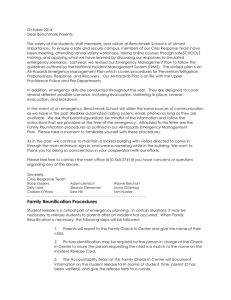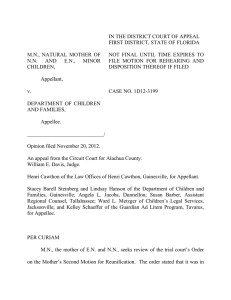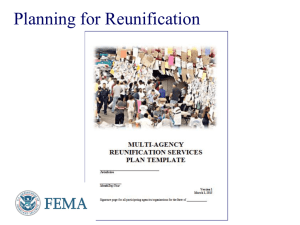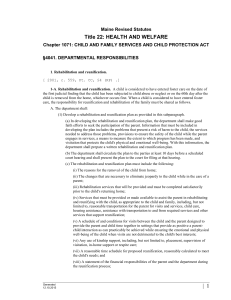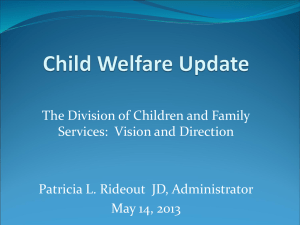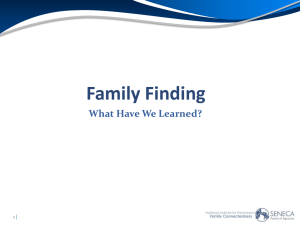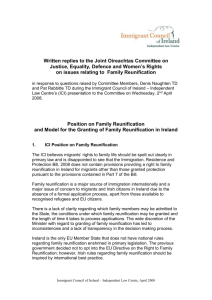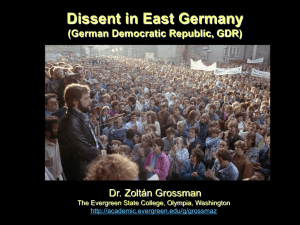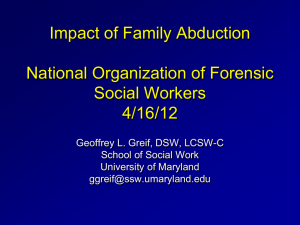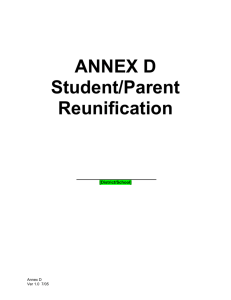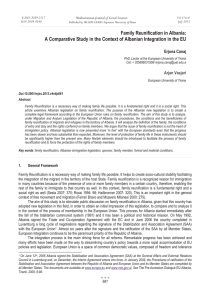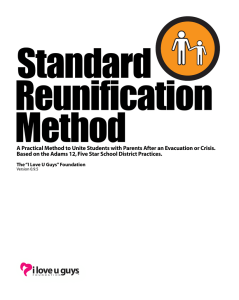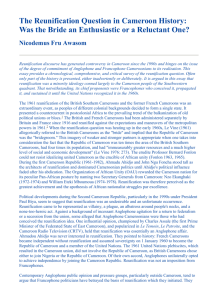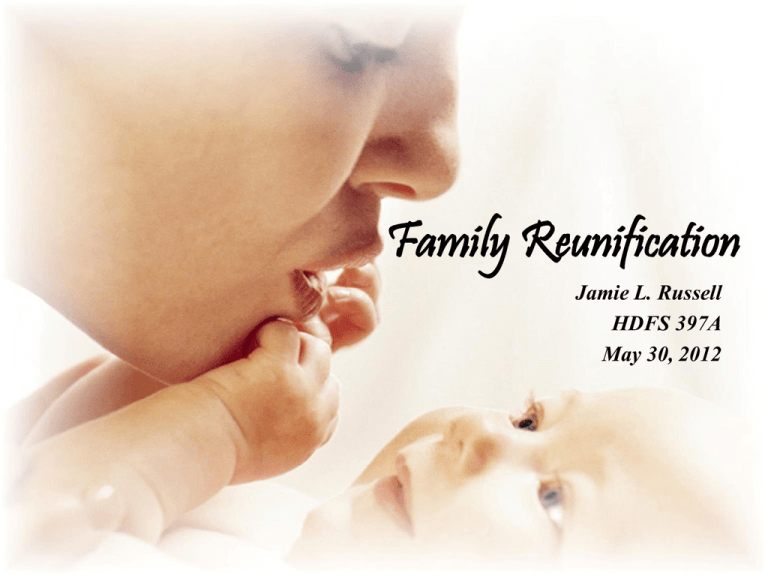
Family Reunification
Jamie L. Russell
HDFS 397A
May 30, 2012
History and Context
•
•
•
Increased awareness of child abuse and interventions.
Reporting laws were put into effect which led to increase of children in foster care.
1980- Adoption Assistance and Child Welfare Act established to keep families together.
– Made it difficult to keep children safe because of the emphasis on preserving families.
•
•
•
•
1994- Funding made available for adoption /foster care analysis and reporting
systems.
1997- Adoption and Safe Families Act revised the 1980 act to make safety of children a
top priority.
March 2000- Child and Family Services State Reviews required to assess domains of
safety, permanency, and family and child well-being.
Family reunification today.
– Goals are to preserve families while
keeping child safety a top priority.
(Courtney, Needell, & Wulczyn, 2004; Myers, 2010)
Federal Requirements
•
Federal law requires states to demonstrate that reasonable efforts are made to:
– Provide services that prevent children from being removed from their homes.
– Make it possible for families to reunited in the event that children are placed
in out-of-home care.
•
In the event that reunification is not in the child’s best interest:
– Many states are responsible for finding safe, permanent placements
for children if the court determines parent(s) unfit.
•
Reasonable efforts are not required when:
– The child is exposed to aggravated circumstances.
– The parent commits murder or voluntary manslaughter of
another child of the parent or a felony assault that results in
serious bodily injury to a child of the parent.
– The parent aids, abets, attempts, conspires, or solicits murder
or voluntary manslaughter of another child of the parent.
– The parent’s rights to the child’s sibling are terminated
involuntarily.
(U.S. Department of Health and Human Services, 2009 & 2011)
Family Reunification in Pennsylvania
• What are reasonable efforts?
– Efforts that assist children and their parents.
– Services that prevent future maltreatment.
• Reasonable efforts are required:
– To prevent or eliminate the need for protective custody.
– To make reunification possible.
– To make permanency plans final.
• Reasonable efforts are not required:
– When the court has determined that aggravated
circumstances exist and no new or
additional efforts are required.
(U.S. Department of Health and Human Services, 2009)
Family Reunification in Pennsylvania
• What does Pennsylvania consider an aggravated circumstance?
– When the child is in custody of the county agency; the identity of the parent is
unknown; and the parent does not claim the child within 3 months or has
failed to maintain contact for a period of 6 months.
– When the child or another child of the parent has been the victim of a
serious physical abuse, sexual violence, or aggravated physical
neglect by the parent.
– When the parent has been convicted of any of the following
crimes in which the victim was a child: criminal homicide,
aggravated assault, rape, statutory sexual assault, indecent
assault, or the attempt to commit any of these crimes.
– When the parent’s parental rights to another child have been
terminated involuntarily.
(U.S. Department of Health and Human Services, 2009)
How Does Pennsylvania Compare?
• Additional grounds for not making reasonable efforts in other states:
– The Parent:
• Abandons a child (28 states and PR)
• Abandons an infant (9 states)
• Is convicted of murder or voluntary manslaughter of the other parent. (12 states)
• Previously had a child removed for abuse or neglect. (9 states and PR)
• Fails to comply with the reunification plan. (6 states and PR)
• Has been incarcerated for a duration of the child’s age and no other relative is suitable to
care for the child. (7 states)
• Has a mental illness that makes it impossible to resume care of the child within a
reasonable amount of time. (6 states and PR)
• Chronically abuses drugs or alcohol and has failed or refused
treatment. (7 states and PR)
• Lacks interest in reunifying with the
child. (2 states and PR)
(U.S. Department of Health and Human Services, 2009)
How Does Pennsylvania Compare?
• Other grounds in 1 or 2 other states:
– A newborn tests positive for alcohol or controlled
substances. (Florida)
– A putative father fails to establish paternity. (Montana
and Nevada)
– The Parent:
• Withholds medical treatment or food from the child.
(Ohio)
• Allows the child to be present where an illegal
laboratory is operated. (Utah)
• Is convicted of being a sexually violent predator.
(Washington)
(U.S. Department of Health and Human Services, 2009)
Stakeholders
•
•
•
•
•
•
Children
Birth Parents
Friends and Relatives
Foster Parents
Adoptive Parents
Social Workers
• Teachers and Child Care
Providers
• Politicians
• Tax Payers
• Communities
• Etc.
Un intended Consequences
• Focus is on parental rights rather than best practices intended for
typical, healthy development for children.
• Family reunification slows down the process of removing
children who are in danger of maltreatment.
• Once children are reunified there is a chance that they
may be re-victimized.
• In some cases, reunification policies lengthen the
time it takes for children to acquire permanency
and may increase the likelihood of placement
instability.
(Akin, 2011; Courtney, Needell, & Wulczyn, 2004)
Successful Reunification
• Concrete services
– Food, transportation, housing, and utilities.
• Substance abuse treatment
– Intensive case management.
• Eliminating barriers to recovery
– Tailoring programs for women with children
• Employment, education, family and children services.
– Strong social support
• Home-based services
– Intensive casework services, parenting and life skills education, family-focused
treatment, access to community resources.
• Post-reunification services
(U.S. Department of Health and Human Services, 2011)
Making Changes in Policy
• Early permanency and stability need to be added to the list of priorities for
protecting children.
– Re-evaluate the time-limits on reunification efforts.
– Add family assessments for temporary placements.
• Social workers making decisions to reunify children should
have specialized training and educational requirements, as
well as greater experience.
– Provide special guidelines when dealing with families with multiple
risk factors.
– Limit the number of cases that case workers are given to avoid
burnout and adequate service delivery.
• Post-reunification services should be required as part
of the reunification plan.
(U.S. Department of Health and Human Services, 2011)
Barriers Affecting Possible Change
• Every case is different and needs to be evaluated on an individual basis.
• Funding for planning, activities, and placement.
• Low-pay and high turnover in the field of Social Work.
• Parental rights are difficult to terminate.
• Rehabilitation takes time.
(Akin, 2011; Courtney, Needell, & Wulczyn, 2004; U.S. Department of Health and Human Services, 2011)
Discussion
• How much time should a parent be given to rehabilitate issues such as,
substance abuse and mental health? What if there is a combination
of risk factors?
• Should there be a limit to the number of attempts to reunify
families after subsequent abuse?
• Who should be responsible for tracking post-reunification
services? Why?
– Courts? Social workers? Family?
• What would you like to see added or taken away from
Pennsylvania's list of factors in which reasonable
efforts are not required to remove a child from their
home?
– Will these changes:
• Have a balance between child safety and parental rights?
• Create higher turnover/burnout for social workers?
• Be cost-effective?
References
Akin, B. A. (2011). Predictors of foster care exits to permanency: A competing risks analysis
of reunification, guardianship, and adoption. Children and Youth Services Review, 33, 9991011.
Courtney, M. E., Needell, B., & Wulczyn, F. (2004). Unintended consequences of the push
for accountability: the case of national child welfare performance standards. Children and
Youth Services Review, 26, 1141– 1154.
Myers, J. E. (2010). The APSAC handbook on child maltreatment (3rd ed.). Thousand Oaks,
CA: Sage Publications.
U.S. Department of Health and Human Services. (2011, June 27). Child Welfare Information
Gateway. Retrieved May 28, 2012, from Family Reunification: What the evidence shows:
http://www.childwelfare.gov/pubs/issue_briefs/family_reunification/family_reunification.pdf
U.S. Department of Health and Human Services. (2009, November 17). Child Welfare
Information Gateway. Retrieved May 24, 2012, from Reasonable efforts to preserve or
reunify families and achieve permanency for children: Summary of state laws:
http://www.childwelfare.gov/systemwide/laws_policies/statutes/reunifyall.pdf

